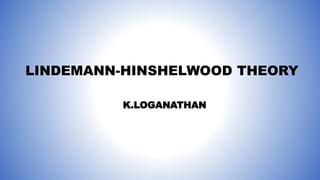
Lindemann theory
- 2. Sir Cyril Hinshelwood The Nobel Prize in Chemistry 1956 was awarded jointly to Sir Cyril Norman Hinshelwood and Nikolaevich "for their researches into the mechanism of chemical reactions."
- 3. Many reactions take place by mechanisms that involve several steps. In each case it is possible to approach the setting up of rate law by proposing a mechanism and, when appropriate applying the steady State approximation. Some take place at a useful rate only after absorption of light or if a catalyst is present. In the following sections we begin to see how to develop the ideas introduced so far to deal with these special kinds of reactions..
- 4. Unimolecular reactions A number of gas-phase reactions follow first-order kinetics, as in the isomerization of cyclopropane mentioned earlier: 𝐜𝐲𝐜𝐥𝐨 - 𝐂 𝟑 𝐇 𝟔 → 𝐂𝐇 𝟑 𝐂𝐇 = 𝐂𝐇 𝟐 𝒗 = 𝐤 𝐫[𝐜𝐲𝐜𝐥𝐨 - 𝐂 𝟑 𝐇 𝟔] The problem with the interpretation of first-order rate laws is that presumably a molecule acquires enough energy to react as a result of its collisions with other molecules. However, collisions are simple bimolecular events, so how can they result in a first-order rate law? First order gas-phase reactions are widely called ‘unimolecular reactions’ because they also involve an elementary unimolecular step in which the reactant molecule changes into the product. This term must be used with caution, though, because the overall mechanism has bimolecular as well as unimolecular steps
- 5. A representation of the Lindemann– Hinshelwood mechanism of unimolecular reactions. The species A is excited by collision with A, and the energized (excited) A molecule (A*) may either be deactivated by a collision with A or go on to decay by a unimolecular process to form products
- 6. Lindemann–Hinshelwood mechanismns The first successful explanation of unimolecular reactions was provided by Lindemann in 1921 and then elaborated by Hinshelwood. In the Lindemann–Hinshelwood mechanism it is supposed that a reactant molecule A becomes energetically excited by collision with another A molecule in a bimolecular step The energized molecule (A*) might lose its excess energy by collision with another molecule: Alternatively (), the excited molecule might shake itself apart and form products P. That is, it might undergo the unimolecular decay 1 2 3
- 7. If the unimolecular step is slow enough to be the rate-determining step, the overall reaction will have first-order kinetics, as observed. This conclusion can be demonstrated explicitly by applying the steady-state approximation to the net rate of formation of A* This equation solves to so the rate law for the formation of P is 5 6 4
- 8. At this stage the rate law is not first-order. However, if the rate of deactivation by (A*,A) collisions is much greater than the rate of unimolecular decay, in the sense that then we can neglect kb in the denominator and obtain Lindemann–Hinshelwood Rate Law Equation(7) is a first-order rate law, as we set out to show The Lindemann–Hinshelwood mechanism can be tested because it predicts that, as the concentration (and therefore the partial pressure) of A is reduced, the reaction should switch to overall second-order kinetics. Thus, when ka ′ [A] << kb, the rate law in eqn 6 is 7 8
- 9. The physical reason for the change of order is that at low pressures the rate-determining step is the bimolecular formation of A*. If we write the full rate law in eqn 6 as then the expression for the effective rate constant, kr , can be rearranged to Hence, a test of the theory is to plot 1/kr against 1/[A], and to expect a straight line. This behaviour is observed often at low concentrations but deviations are common at high concentrations. Effective Rate constant (Lindemann–Hinshelwood mechanism) 9 10
- 12. Lindemann theory breaks down for two main reasons: i) The bimolecular step takes no account of the energy dependence of activation; the internal degrees of freedom of the molecule are completely neglected, and the theory consequently underestimates the rate of activation. ii) The unimolecular step fails to take into account that a unimolecular reaction specifically involves one particular form of molecular motion (e.g. rotation around a double bond for cis-trans isomerization).
